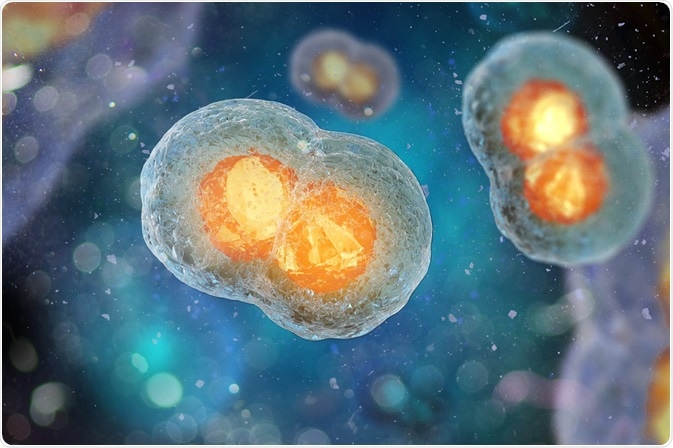The proteome, defined as the complete set of proteins within an organism, is maintained by a highly controlled process called proteostasis.
 Image Credit: Andrii Vodolazhskyi / Shutterstock
Image Credit: Andrii Vodolazhskyi / Shutterstock
As an organism ages or is afflicted by a disease/disorder, the proteostasis network is altered which leads to an accumulation of damaged and misfolded proteins.
Aging
Aging is a process that is not yet fully understood. Model organisms, such as the nematode, Caenorhabditis elegens, are often used in genetic studies of tissue aging.
There are a number of cellular pathways that regulate the aging process, of which three main pathways that can alter the rate of aging have been identified; the mitochondrial electron transport chain, the insulin/insulin-like growth factor (IGF) 1 signaling pathway and the FOXO3/Sirtuin (dietary restriction - DR) pathway.
Studies have reported that the process of aging is accompanied by numerous hallmarks. These are instability of the genome, epigenetic changes, shortened telomeres, proteostasis loss, reduction of stem cell stores and a decrease in mitochondrial function. These hallmarks are also accompanied by changes within the proteome, including protein aggregation, oxidation, and mislocalization.
Proteostasis
The proteostasis network contains over 1,400 different proteins such as chaperones, co-chaperones, ribosomes, and factors that are involved in the degradation of proteins.
The first component of this network is the ribosome that synthesizes polypeptide chains via the translation of RNA. Once this chain is complete, chaperones can then aid protein folding. An example of a chaperone is Hsp70, which binds to un-folded polypeptide chains and prevents aggregation.
Another example is Hsp60, which isolates unfolded proteins and stimulates correct folding. Chaperones also function in stressful conditions to minimize protein damage and up-regulate protein repair in a process called the heat-shock response.
An additional component of the proteostasis network is the degradation of damaged or misfolded proteins. These proteins are broken down utilizing degradation machinery such as the ubiquitin-proteasome pathway and lysozymes.
Overall, proteostasis ensures that proteins are correctly folded and maintained at appropriate levels. This network is also very important in preventing the occurrence of proteopathies such as Alzheimer’s disease.
The effect of aging on proteostasis
As an organism ages, protein damage occurs from exposure to various chemicals, UV radiation and environmental toxins. This may lead to a build-up of large quantities of misfolded and damaged proteins. These proteins also target other proteins and lead to further aggregation and misfolding.
Although chaperones are small molecules that assist in protein folding, age-related changes also influence their function. For instance, reduced mitochondrial function that is common in old cells, results in a decrease in available ATP. ATP is required for chaperone function and therefore a decrease in ATP availability inhibits their function causing incorrect folding and accumulation.
It has been noted that the abundance of chaperones decreases as an organism ages. In addition, the types of chaperones involved also change with aging. However, the functional significance of this has not yet been established.
Another proteostasis process, which is impacted by age, is the destruction of misfolded and damaged proteins. Proteasomal degradation, for example, is dramatically reduced in older cells. This pathway usually targets cells by the addition of ubiquitin to unwanted proteins that are then targeted by the proteasome.
However, the changes associated with aging inhibit this process. Lysosomes are also affected leading to a dramatic reduction in autophagy.
Proteostasis, aging and disease
The proteostasis network decreases in capacity as we age and may lead to diseases due to accumulation of misfolded or degraded proteins. These diseases, such as Alzheimer’s, Parkinson’s and Huntington’s diseases, result in toxic protein build-up and have far-reaching health implications.
The damage that accumulates as a process of aging may not be entirely reversible due to the complex internal processes and pathways. However, studies have demonstrated that the process of proteostasis can be maintained by restriction of calorie intake.
This has been shown to increase the lifespan of rats by up to 50%. Stem cell studies have also indicated that proteostasis maintenance might be an important factor in organismal aging.
In addition, studies have analyzed the chaperone dynamics on human brain and neurodegenerative disease and their subsequent effect on senility. It was observed that a subset of chaperones were critical in maintaining proteostasis with aging. Further research on the modulation of proteostasis network may be an answer to some of the medical problems faced by the aging population.
Further Reading